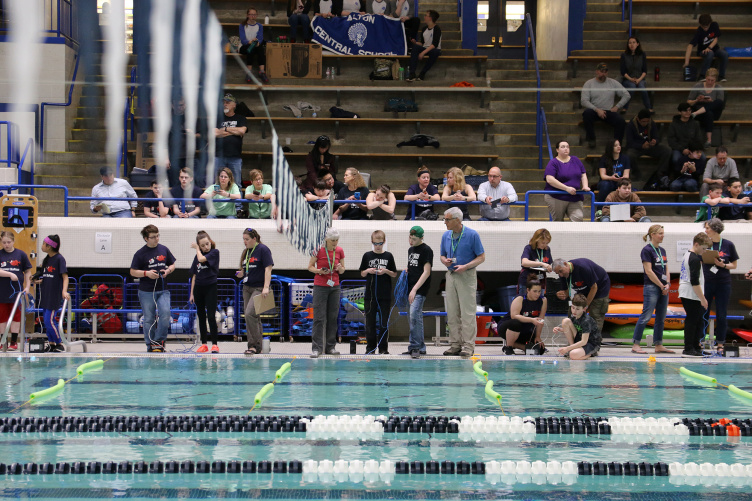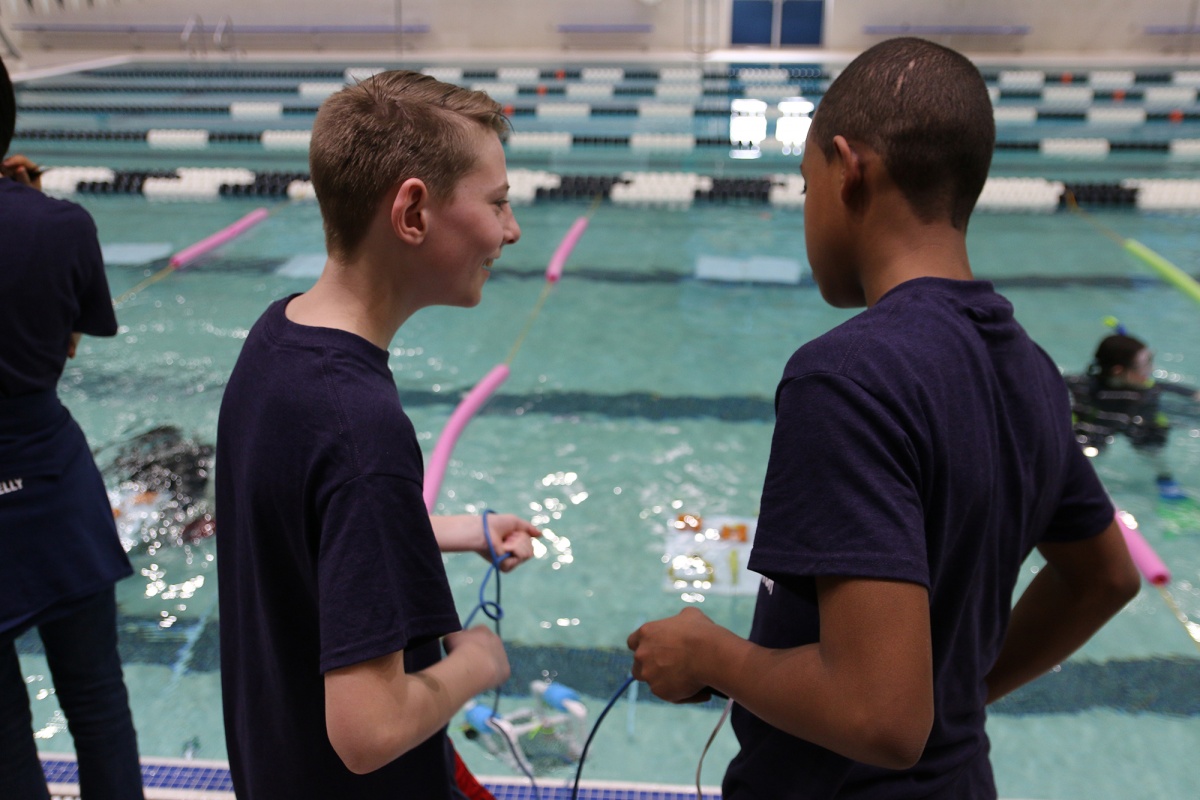
When it comes to designing and building underwater remotely operated vehicles (ROVs), it’s not enough to measure twice and cut once. For the young engineers who participated in this year’s Seacoast SeaPerch regional competition, held on April 13 at the Swasey Pool at UNH, four or more rounds of measuring were necessary to make their ROVs water-ready.
Building an ROV “taught me how important it is to measure properly. It took me about a month to get this whole thing correct,” said Matt Bonner, a student at Alton Central School. Bonner’s team was one of the 50 representing more than 20 schools, 4-H clubs and after-school programs from New Hampshire, Maine and Massachusetts at the competition.
"They’re learning technical reading and writing skills, learning the engineering thought process."
SeaPerch is an international underwater robotics program that teaches basic science, technology, engineering and math (STEM) concepts with a marine engineering theme. The annual Seacoast SeaPerch event is the result of collaboration among UNH Cooperative Extension, the UNH Center for Coastal and Ocean Mapping (CCOM) and the Portsmouth Naval Shipyard (PNSY).
Cooperative Extension partners with CCOM to train volunteers and educators to participate in SeaPerch and host the annual competition. “The Shipyard provides the building kits for the ROVs, and all three organizations work together to train educators,” said Claes Thelemarck, a STEM education field specialist with Extension.
While some teams and their robots battled it out in the Swasey Pool, racing to complete an obstacle course and a challenge competition, others gathered in the Service Credit Union Victory Club at Wildcat Stadium to show off posters detailing the design and construction of their robots.
“We've been partnering with the Portsmouth Naval Shipyard for more than seven years now on SeaPerch, and it's proved to be a really wonderful pairing. The shipyard sends their volunteers to schools and training events and helps guide students through the construction and design of the ROVs,” said Tara Hicks Johnson, CCOM outreach specialist. “Then students bring their completed robots to UNH to test them out, sometimes using the same facilities that we use to test our tethered and autonomous robots. They get to meet current UNH students who are pursuing degrees in this field and hopefully start to see themselves here at UNH, and then working at the Shipyard.”


U.S. Sen. Jeanne Shaheen and PNSY Commander Capt. David Hunt helped kick off the competition.
During his opening remarks, Hunt stressed the importance of the ongoing collaboration. And he encouraged students to embrace the challenges that come with making ROVs.
“Have fun as you do this, and learn from your mistakes and learn how to overcome. That’s part of the learning process, and part of the foundation you’re building as you learn these skill sets,” he said.
Watching the competition, Shaheen noted that the skills SeaPerch participants learn are important for the state and national economy. “This is a wonderful partnership between UNH and the Portsmouth Naval Shipyard and all the schools and clubs and organizations that participate, because it gets kids excited about STEM in a hands-on way that hopefully carries over into the classroom and into their futures,” Shaheen said.
Ed Cormier, the engineering recruiter and STEM outreach coordinator at the Shipyard, said SeaPerch yields big benefits for students throughout the region.
“They’re learning technical reading and writing skills, learning the engineering thought process. It’s a great program that schools and 4-H and other programs can get into for a low cost, but that also hits major points in the STEM pipeline. It’s great not just for engineering students, but students who are going into trades, as well,” Cormier said.
The students, themselves, had more immediate concerns. The Rogue Robots of 4-H fielded two teams this year: Galaxsea and Water Wizards 2.0. Between rounds, the teams worked out some final design wrinkles and practiced driving their ROVs.
This was the second year in the competition for the Water Wizards, made up of Anna Numme, Wilson Zhang and Christian Picard. “We used a similar design to last year, but we made it more compact, added 3-D printed motor mounts, sealed the frame and added weights and floats,” Numme said. The team’s greatest challenge was designing a vehicle that would be compact enough to navigate the obstacle course, but also sturdy enough to carry weighted items between two platforms during the challenge competition.
Austin Preparatory Academy and Andover High School took top honors in the competition. They’ll take part in the International SeaPerch Challenge at the University of Massachusetts Dartmouth later this year.
As Alton middle schoolers Matt Bonner, Nick Reed, Amya Portigue and Alex Gagne reflected on the work it took to construct their vehicle, dubbed The Deep Sea Demon, out of PVC pipes, pool floats and other parts, they discussed the challenges of designing and 3-D printing specialty parts, unlocking the mysteries of buoyancy and making sure their measurements were really, really accurate. What were they most excited about in the end?
“The fact that it actually works!” said Portigue.
“It took four times, a lot of trial and error, and a lot of superglue,” Gagne said.
-
Written By:
Larry Clow '12G | UNH Cooperative Extension

















































